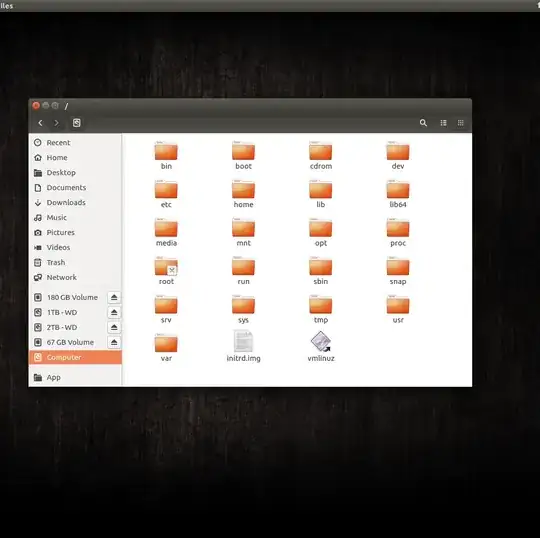I have four hdd in my pc. one of them is installed with windows7 and one of them is recently installed with ubuntu 16.06 and two of them are just for storage.
After ubuntu is installed, I clicked on files which brought me to home. Then I take a look to the left, I can't seem to understand why is there a 67GB column which can be unmounted.
There is
- 180GB volume - which is my windows7
- 1TB - WD - storage
- 2TB - WD - storage
- 67GB Volume - which I have no idea what this is
- Computer - which I suppose is the root structure for ubuntu
4 and 5 looks super similar though
This is what the 67GB Volume looks like which I have no idea what it is

This is what Computer looks like
Edit:
in df it looks like
Filesystem 1K-blocks Used Available Use% Mounted on
udev 3999404 0 3999404 0% /dev
tmpfs 803744 9904 793840 2% /run
/dev/sdd1 472468752 4670968 443774644 2% /
tmpfs 4018712 232 4018480 1% /dev/shm
tmpfs 5120 4 5116 1% /run/lock
tmpfs 4018712 0 4018712 0% /sys/fs/cgroup
tmpfs 803744 44 803700 1% /run/user/1000
lsblk looks like
NAME MAJ:MIN RM SIZE RO TYPE MOUNTPOINT
sda 8:0 0 238.5G 0 disk
├─sda1 8:1 0 100M 0 part
├─sda2 8:2 0 168.1G 0 part
├─sda3 8:3 0 1K 0 part
├─sda5 8:5 0 62.4G 0 part
└─sda6 8:6 0 7.9G 0 part
sdb 8:16 0 931.5G 0 disk
└─sdb1 8:17 0 931.5G 0 part
sdc 8:32 0 1.8T 0 disk
└─sdc1 8:33 0 1.8T 0 part
sdd 8:48 0 465.8G 0 disk
├─sdd1 8:49 0 457.9G 0 part /
├─sdd2 8:50 0 1K 0 part
└─sdd5 8:53 0 7.9G 0 part [SWAP]
sr0 11:0 1 1024M 0 rom



GPartedplease attach screen – Mohamed Slama Jun 11 '16 at 03:13GParted? sorry I am really new to ubuntu – Dora Jun 11 '16 at 03:59dfcommand in terminal. So click on the Ubuntu icon on the launcher and type in terminal, then select that app. Once it shows, typedfand press enter. Also addlsblkoutput. Copy the text , don't post the screenshot ( the screenshots of just text is not very welcome here ) – Sergiy Kolodyazhnyy Jun 11 '16 at 04:25df lsblkright? (Because I don't really understand what meant addlsblkbut I will do that after 13-14hrs haha at work now. Also, I wasn't sure if I installed ubuntu two times in the same hdd because there were some confusions earlier when trying to install ubuntu. But I thought when installing, I did use format the drive and using the max disk space. Anyways thanks I will try that command and see what's the output – Dora Jun 11 '16 at 04:29dfand the output oflsblkas serg mention. – Mohamed Slama Jun 11 '16 at 04:36lsblkanddfare two separate commands. So first typedfand it will spit out some text, then typelsblkand that will spit out different text. – Sergiy Kolodyazhnyy Jun 11 '16 at 05:40